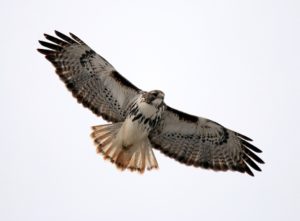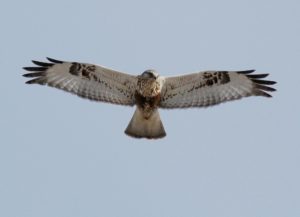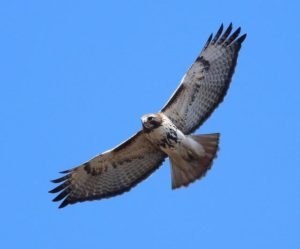General Reflections Based on Surveys in McLean and Woodford Counties
In the fall of 2007, Matthew Winks and I created an approximately 50 mile winter raptor survey route that begins an ends at the Fraker Farm abode. This route heads east south of the Mackinaw River past Evergreen Lake to Lake Bloomington where it crosses north across the Mackinaw, heading back west all the way to the Congerville Road, and then back south across the Mackinaw for a weaving, wandering route that heads back to the east to its finish.
Over its almost 10 year history, this route has been amazingly productive for raptors, with total counts usually finishing in the 70s or 80s, and the best counts pushing 100 birds.

A quick summary of raptor abundance for the most part yields few if any surprises. Northern Harriers present consistently but in variable numbers depending on the year. Cooper’s and Sharp-shinned Hawks, while clearly present, can be a tough get. Red-shouldered Hawks are resident in this corridor of the Mackinaw River, albeit in small numbers that always provide excellent eye-candy moments when they decide to pop-up on survey day. Bald Eagles are a solid winter presence here, and are now also breeding in several sites along the upper Mackinaw. Merlins and Peregrines remain very scarce on these surveys, but have graced them on a couple of occasions while American Kestrels have a healthy presence here.
The two species that make for the most striking presence on this route largely due to their migratory presence are Red-tailed Hawks and Rough-legged Hawks.
Rough-legged Hawks occur in sections of this route with an impressive frequency. Most of the birds are juveniles or adult males (not surprising as the males tend to wander farther south than the females do in most years). We generally see more light phases than dark phases, but the darker birds are always at least annual.

Yet it is our most common raptor that has become the most interesting. Red-tailed Hawks are the “Herring Gulls” of the hawk world. With tremendous inherent variation just in the “Eastern” (borealis) subspecies alone, our “meat and potatoes” most common raptor here, we then must add several other variants of Red-tailed Hawks present here in winter to get the full, complicated, and often confusing picture. These additional variants include “Harlan’s” (harlani), “Krider’s” (kriderii), “Western” (calurus), and “Northern” (abieticola).
“Harlan’s” Hawks are very rare but almost annual in central Illinois, with the more common darker phases being expectedly more often documented, although here in our survey corridor, we have documented the much rarer lighter phase Harlan’s on at least three occasions (including an adult this year right by the Fraker Farm).
“Krider’s” variants are also almost annual, but can be difficult to confirm due to a sliding scale of inherent variation in “Easterns”.
“Northern” Red-tailed Hawks represent a subspecies that has only recently gained a whole lot of attention. Out of all the different variants mentioned, these tend to be the least rare of the non-“Eastern” versions, with several being found annually in central Illinois.

And finally there is the “Western” Red-tailed Hawk, or the calurus. One of the larger mysteries surrounding Illinois winter raptors is why so many gorgeous dark-phase “Westerns” get well documented, and yet not a single light-phase calurus can make it into the Illinois books. Distributionally, it makes zero sense that dark “Westerns” show-up annually, probably more so than “Harlan’s”, but light “Westerns” never get here.
Or are these dark “Westerns” actually true calurus?
An interesting theory behind the disparity between phase presence of “Westerns” here in Illinois is that maybe all of our dark “Western” birds are actually dark “Northerns” (abieticola). Because field identification of a dark “Western” versus a dark “Northern” at this point is not feasible, only some sort of physical monitoring (bands, satellite, tags) of these dark “Western” type birds that show-up in the east might lead us to where they return in spring helping us uncover whether or not these dark mystery birds are “Westerns” or “Northerns” (entire paragraph pers.comm. Jerry Liguori).
While winter can be a season of dread for Illinois residents, for many of us it is yet another great season for getting out to find birds — raptors especially. Try to photograph or at least pay closer attention to every winter Red-tailed Hawk that you safely can — it is almost guaranteed that at some point during a winter you’ll photograph/see a special wanderer from afar.
by Matt Fraker
